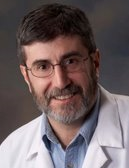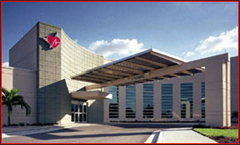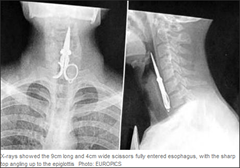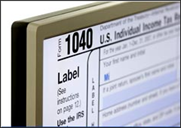.!.
Two Thirds of the NHIN by 2010 (or, Not Your Daddy’s CHIN)
The Nationwide Health Information Network. By 2014. That’s the timeframe we’ve all heard about since GWB, Michael Leavitt, David Brailer, et al, began the ball rolling from a governmental initiative perspective about five years ago. So, half the time has passed and we’re halfway there, right?
OK, it seems Sisyphus had an easier time reaching the mountaintop with his boulder than we’re having with this NHIN rock. It has been more than 25 years since some pretty smart people saw the advantages of using electronic brains to assist with the collection, manipulation, and dissemination of healthcare information. Yes, we have seen the pioneers and the early adopters join in the uphill shove, but we are currently so far away from any sort of national healthcare data sharing that it is almost comical. (Have you ever tried to aggregate old records for a patient who has seen three doctors, two ERs, an urgent care, and a couple of health departments in the past few years?)
So, on to Step 3 of the “Official Grunt-in-the-Trenches Complete U.S. Healthcare System Overhaul and National Health Information Network in Five Easy Steps Disruptive Innovation Package.”
Is it really possible to achieve 70% of the NHIN by 2010? (Well, maybe 2011, but NHIN and 2010 have a better rhythm!)
Yes. Period.
I know, I know. Many with far bigger brains than my little peanut tell us the interoperability difficulties, the interfaces required, the rules, and the regulations are almost insurmountable with our current systems. And, maybe … maybe they are correct. With “our current systems” maybe there is no hope. But, have you ever noticed how many times throughout history that the prominent intelligentsia got it wrong? Have you noticed how many times those who discuss why things can’t be achieved are eclipsed in the historical record by those who say, “Why not?”
Well, here goes my next shot at “Why not?” and – hey, it could happen – a historical footnote. (For the first shot, see Step 2.)
We have been focused upon building these big center systems – the RHIOs, HIEs, and their ilk – and then figuring out how to connect all these silos, these disparate giant Sequoias of information. Well, first, did I miss something? Don’t we have connectivity? Doesn’t this massive information exchange system already exist as a little thing called the Internet? (Internets, according to some.) So, if you and I can exchange information – as we are right now, regardless of where you are – how is it that we need these massive health information exchange projects to send data across town? Is health information somehow different? Does the exchange of health data involve some unique form of electrons or a specialized set of zeroes and ones compared to lay data? Doesn’t seem to be a problem for first cousin Finance.
Why not…consider a different approach to both linking healthcare professionals and motivating participation in the Grand Healthcare Digitization Project, participation of both providers and the general population? Does the fact that we have already invested oodles of money in current projects preclude the thought trail which veers sharply away from the current, overly beaten track?
Why not … convince health systems and providers to understand that patient health data is not “owned” by anyone except the patient, that sharing that info is not counterproductive to corporate profits but rather contributive, once all are duly linked?
Why not … start building a system less filled with silos, less federated, and begin endorsing truly integrative designs, designs which take advantage of the connectivity we already have and utilize that connectivity to motivate usage?
What I’m saying is, there are certain systems and/or design elements already available which could integrate and inspire usage and adoption of both providers and public. We are not focusing upon them, at least in part, because of earlier (and some current) failures of integrative-type systems. (CHINs, RHIOs, etc.) Regrettably, those systems had some grossly neglectful design flaws: they were built upon financially unsustainable models and/or they did not take basic human motivations into sufficient consideration.
Here’s the skinny on attaining 60-70% of the NHIN (OK, it’s a somewhat chubby skinny):
a) Small communities and their associated small community hospitals serve an estimated 60-70% of the U.S. population. (See where this is going?)
b) Let’s utilize the power of “community,” a strong force within small towns, to help inspire adoption and conquer the learning curve necessary for this “paradigm shift.” (Sorry…I hate such corporate-speak clichés, too.) Enabled consumers and ancillary medical services providers – EMS, police, fire, sheriffs, home health, hospice, health departments, school nurses, etc. – will entice physicians to adoption by their creation of a need to which the docs can respond, this response being something of a forté for most clinicians. (Commercials with the local fire chief and Little Timmy or Grandma Gertie, who were saved because emergency responders had access to important health data at critical moments will drive digital participation far more than, “Look, see how many demographic or health history boxes we have for you to fill out.” Enabled patients will begin to ply their caregivers for participation with community-based digital care basics.)
c) The “Promised Land” of EHR/PHR use involves all of the tremendous information, subsequent insights, availability, and integration said info will provide. But, we delay our journey by focusing upon all of the wonders to come. Small bites, small sips – that is what consumers and physicians need to start along the path out of the Paper-filled Desert. Don’t blind them with the overwhelming roar of the “Voice of the ‘Almighty’ EHR.”Rather, allow all us Moseses to hear the Word and feed the people those portions which they can tolerate as we attempt to lead them out of the paper-filled desert. (Read this as: Institute small, valuable tools in modular form that can provide immediate, real life value and then build upon this foundation with additional modules providing increasing value in tolerable, stepped progressions.)
d) Using the tools mentioned in Step 2 – an end user-friendly system with simple, familiar tools and goops of support and education, along with an open, but secure, design that is inclusive (read: non-proprietary or, at the very least, one that works and plays well with others) – we establish a local non-profit governance organization to oversee and insure local concerns. (A for-profit corporation to help establish and support these local 501(c)3s would likely be more fleet-footed than a governmental oversight org.
e) Within each community, while we enable bridging the digital divide in these typically less technologically advanced populations, we would create a minimum of 10 to 20 new jobs (20 X 2,000 = 40,000 new jobs) for support and education services. We would also enable small hospitals to retain employees, a current, major challenge. (Our local hospital recently had to let 50 people go: 50 X 2,000 = a possible 100,000 jobs saved.)
f) Utilizing a combination of tools, such as the Health Record Bank, so pleasantly detailed at HIMSS by Drs. Deborah Peel and Bill Yasnoff, along with the Integrated Health Record (IHR,) as discussed in Step 2, we could create a patient-centric, patient-controlled, community-driven healthcare model which, with one of the available integration/exchange engines – for instance Medicity’s Care Collaboration Platform – would allow for a truly inclusive, integrated healthcare community system. All could participate, including new and legacy systems.
g) Such community systems, based upon designs specifically for small communities, would not provide Mayo-esque, Rolls Royce-type digital healthcare magic. They would, nonetheless, provide what small communities actually need: the initial Honda Civic version that may have few bells or whistles but can get us from paper (here) to electronic (there) healthcare – or at least down the first part of the journey. Once small communities have given up their horse-and-buggy (paper full) systems, they will be able to actually share basic healthcare data seamlessly, as their systems’ similarities will allow such sharing, and we can add new modular enhancements as people become more and more comfortable with their new mode of healthcare data transportation (less paper.)
h) Small communities rarely have competing hospitals. Sharing data between such communities would not engage the “it’s my data, you can’t have it” seen within larger centers. With appropriate consent and protections, sharing across the biggest HIE pipeline (the Internet) between small communities would only boost information access, enable less costly care provision, and promote small center usage by consumers who can receive higher quality care closer to home.
To recap (i.e., the skinny skinny):
- Most folks get care outside of giant centers in small communities and their associated community hospitals (60-70% of NHIN)
- Design specifically for small communities (i.e., no ill-fitting trickle down)
- Graduated, modular development (no “drink from the fire hose”)
- Immediate, real world value to inspire participation (school & home health & nursing home & hospice telemedicine services, care reminder services, real “saved lives” via first responders now)
- Patient-centric, community-driven (LOADS of support/education, opt-in only, local governance)
- Community to community connectivity with Aspen-like interrelatedness (compared to our current siloed Sequoia-like systems)
- User-friendly, customizable, intuitive, simple, familiar tools (think cell phone apps, JAVA, Flash, video, “fun” elements, community kiosks, local education sessions by locals, door-to-door help and support)
- Utilize “natural human motivations” to inspire co-adoption and conquer learning curves (en masse, in community, we are more inspired, more driven)
I promised at least a Tweet about funding and sustainability. So…
Funding? – Obama.
Sustainability? – A permanent Obama aristocracy.
Seriously, yes, we could certainly receive a tremendous bang for a chunk of the Obama bucks. (60-70% of the NHIN using less than 1/3 of the ~$38 billion already planned – e.g., projected costs are far less than 5 million per community X 2,000 communities = <10 billion) Anybody else know of a system or design which could attain two thirds of the NHIN for such a bargain basement, fire sale price?
Sustainability must be derived from a variety, a community, of sources. Just as the community can help drive adoption, so, too, can the community model drive a diversity of ongoing income sources. Besides having EHR vendors pony up some of the development costs for products destined to enhance their ongoing revenue streams, others should participate in supporting this communal sandbox: local employers, local hospitals and physicians via savings and enhanced earnings, HRB service fees, community-based grants via the aforementioned local non-profit, insurance company rebates and support, local levies, and, of course, the traditional small town bake sales and fish fries. Yes, yes, just kidding on those last two, but the point is, with a coordinated effort and a seriously detailed plan, sustainability can be obtained using the same community-based mindset. (It is difficult to detail this adequately within the constraints of a blog…er…”News & Opinion” site. No dis intended, Mr. H!)
Finally, the runway model skinny:
- Start with the basics in small test tube environs, provide adequate growth media, let the system grow along natural growth lines, allow Aspen-like spread and interrelatedness (maybe we should call the system, Pando?) deriving scale via reproducibility, and “allow” all of the beneficiaries to feed and water it ongoing.
As I said, I know there are many really smart people out there who are going to point out the bazillion reasons why this can’t work. Personally, I’ve never found intelligence to be a substitute for initiative. Those who depend upon nay-saying and “why you can’ts” tend only to limit; I more prefer to heed the call of the “Why Nots.”
Still to come:
Step 4: Equalizing the Playing Field (“Open” is not a Four Letter Word; Systems That’d Suit)
Step 5: Verdant Health (Lush, Full, Eco-friendly, Yet More Jobs – “Green” in Every Sense)

Dr. Gregg Alexander is a grunt-in-the-trenches pediatrician and geek. His personal manifesto home page…er..blog…yeh, that’s it, his blog – and he – can be reached through http://madisonpediatric.com or doc@madisonpediatric.com.








The article about Pediatric Associates in CA has a nugget with a potentially outsized impact: the implication that VFC vaccines…